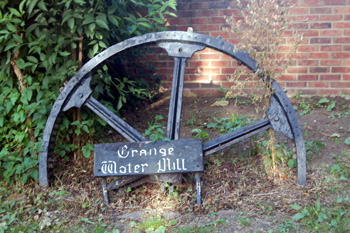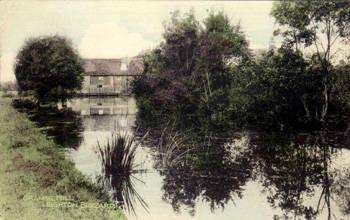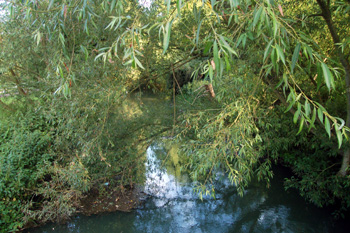Grange Mill Heath and Reach

Grange Water Mill June 2008
The Manor of Gladley, noted in the Domesday Book of 1086, included a mill. Clearly it is not possible to say whether this stood on the same site as Grange Mill stands today but, given that the Manor of Gladley was based in this area of the parish and that the mill could only have been a water mill (windmills were not introduced into England until the end of the 12th century) it cannot have been far away.
The medieval mill formed part of the Manor of Gladley, held by Jocelyn le Breton at the time of the Domesday Book, until the manor was divided into two, roughly north and south by Jocelyn's son Hugh some time between 1131 and 1141. The mill, along with closes later named Home Ground, Little Home Ground, Great Mead and Little Mead, was attached to the smaller, or southern, part which remained in the family of Jocelyn le Breton for some time longer.
By the mid 12th century, however, the mill seems to have become part of the Royal Manor of Leighton as it is mentioned in the grant of that manor to the Abbey of Fontevrault in France by King Henry II in 1164 as having once formed part of the Royal Manor. By 1164 the mill seems to have been given by Henry II to Woburn Abbey although in an inquisition after the death of Lord of the Manor of Gladley Geoffrey de Lucy in 1346 he was described as owning a water mill. It is simply not clear if this is Grange Mill, or a different mill.

Grange Mill about 1900 [Z1130/57]
The current Grange Mill is, if not medieval, certainly old. It was listed by the former Department of Environment in 1979 as Grade II, of special interest. The building is 17th century, with later additions and is built of grey and red brick. It has two storeys, with attics, and a clay tile roof. Some timber framing is visible on the right hand wall as viewed from the front. The miller's house, standing to the south-east of the mill, is not listed, but dates from the 18th century; it is built of brick.
When Heath and Reach was inclosed in 1841 Grange Mill was still part of the Manor, which, by then, had been alienated to Lord Leigh, tenant of the Manor of Leighton Buzzard alias Grovebury under the Dean and Canons of Saint George's Chapel, Windsor. From this point the two manors were made one. The miller in 1841 was Joseph Turney. He had been miller since at least 1838 and would be miller until at least 1848. In 1841 the mill house and garden also included 2 roods 6 poles of land. Directories record more modern millers as below, the dates being the first and last directory in which they are named:
- 1862: A. Roades: 1862;
- 1876: William Edwin: 1876;
- 1898-1924: George Bates: 1898-1924;
- 1928: Robert Bates: 1928;
- 1931-1940: Bates Brothers: 1931-1940

Grange Mill about 1975
It is curious that there are a number of directories which refer to millers with windmills in Heath and Reach - Thomas Holmes from 1876 to 1885 and Edward Bates from 1885 to 1894. The directories noting these millers make no reference to any other mill in the parish. As far as is known there has never been a windmill in Heath and Reach, though there were at least four in Leighton Buzzard. It seems possible that the reference to Edward Bates having a windmill is a mistake and that he was miller at Grange Mill. Thomas Holmes' windmill may have been in Leighton Buzzard.
Under the terms of the Rating and Valuation Act 1925 every piece of land and building in the country was assessed to determine the rates to be paid on them. Heath and Reach was assessed in 1927 and the valuer visiting Grange Mill [DV1/H31/26] noted that it was owned and occupied by Bates Brothers (despite what the Directory for 1928 said!). The cottage and mill had also included 42 acres of land before the First World War, it now included 65 acres (55 in Heath and Reach and 10 in Leighton Buzzard). Robert Bates had lost a son to the Great War, George Bates was serving with a cavalry unit, the Bedfordshire Yeomanry, when he died of wounds in June 1918. He was 25 and is buried at Abbeville Communal Cemetery Extension.

Grange Mill Cottage June 2008
The mill cottage contained two reception rooms, a kitchen and a dairy on the ground floor with three bedrooms and a box room above. Outside stood a brick and tile washhouse and scullery combined and a weather-boarded and tiled store shed. The valuer considered the buildings: "Good". The accompanying homestead of farm buildings comprised the following:
- in the yard: a weather boarded and corrugated iron piggery; weather boarded and tiled barns; a brick, stone and tile cow house for eight beasts with a hay place; a weather boarded and tiled cattle shed ("now three piggeries"); a piggery; a mixing house; a three bay open cart shed and a trap house;
- Block A: a brick and tile stable for four horses with a loft over; a weather boarded and tiled cart shed for three carts and a brick, stone, wood and tile old mill-house used as hay and chaff store.
The valuer noted the following concerning the mill itself: "Saw Bales - 4 pairs stones. Can work 2. 4 in District all Grist. Bought 1924". Clearly, then, the mill had been bought from the manor in 1924, in the midst of a succession of Law of Property Acts which gradually reduced all manorial powers and dispensed with copyhold tenure. Bedfordshire Mills, written by Hugh Howes and published by Bedfordshire County Council states that the mill ceased working in 1966, since 1930 it had worked grinding animal feed. It was sold in 1979, following its listing by the Department of Environment and, because the listing had not extended to the machinery, some of this was removed in the alterations which followed.

Grange Mill stream May 2008
The description of the water wheels in Bedfordshire Mills is as follows: "The two wheels were made with sheet iron buckets mounted on timber framing. The shafts in both wheels have been replaced by iron. The west mill had an arrangement whereby the water wheel could be disengaged so that the mill could be turned by a portable steam engine standing outside the mill. Both halves contained two pairs of stones and the associated milling equipment".
 Machinery in Grange Mill about 1975
Machinery in Grange Mill about 1975